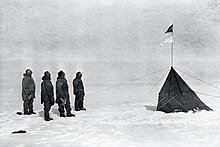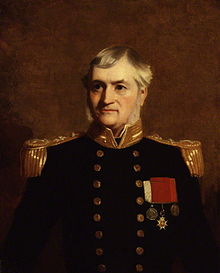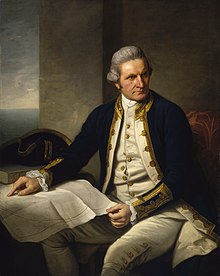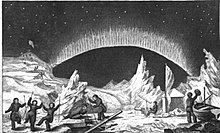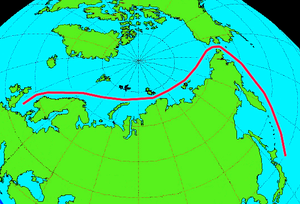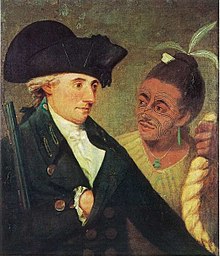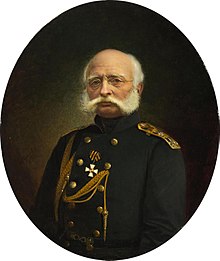User:Godsy/Portal example
Portal maintenance status: (February 2019)
|
Introduction
Polar exploration is the process of exploration of the polar regions of Earth – the Arctic region and Antarctica – particularly with the goal of reaching the North Pole and South Pole, respectively. Historically, this was accomplished by explorers making often arduous travels on foot or by sled in these regions, known as a polar expedition. More recently, exploration has been accomplished with technology, particularly with satellite imagery.
From 600 BC to 300 BC, Greek philosophers theorized that the planet was a Spherical Earth with North and South polar regions. By 150 AD, Ptolemy published Geographia, which notes a hypothetical Terra Australis Incognita. However, due to harsh weather conditions, the poles themselves would not be reached for centuries after that. When they finally were reached, the achievement was realized only a few years apart. (Full article...)
Selected general articles
-
Image 1Avgust Karlovich Tsivolko, also spelled as Tsivolka (Russian: Август Карлович Циволько) (1810 – March 28 (O.S. March 16), 1839) was a Russian navigator and Arctic explorer.
In 1834–1835, Avgust Tsivolko took part in the Pakhtusov expedition towards Novaya Zemlya. In 1837, Tsivolko commanded a schooner named Krotov during the Baer expedition towards Novaya Zemlya. He was the one to map the Matochkin Strait in the course of this expedition. In 1838 Tsivolko was put in charge of the mapping expedition and sent towards the northern and northeastern shores of Novaya Zemlya. (Full article...) -
Image 2

Belgica anchored at Mount William
The Belgian Antarctic Expedition of 1897–1899 was the first expedition to winter in the Antarctic region. Led by Adrien de Gerlache de Gomery aboard the RV Belgica, it was the first Belgian Antarctic expedition and is considered the first expedition of the Heroic Age of Antarctic Exploration. Among its members were Frederick Cook and Roald Amundsen, explorers who would later attempt the respective conquests of the North and South Poles. (Full article...) -
Image 3Fram in Antarctica during Roald Amundsen's expedition
Fram ("Forward") is a ship that was used in expeditions of the Arctic and Antarctic regions by the Norwegian explorers Fridtjof Nansen, Otto Sverdrup, Oscar Wisting, and Roald Amundsen between 1893 and 1912. It was designed and built by the Scottish-Norwegian shipwright Colin Archer for Fridtjof Nansen's 1893 Arctic expedition in which the plan was to freeze Fram into the Arctic ice sheet and float with it over the North Pole.
Fram is preserved as a museum ship at the Fram Museum in Oslo, Norway. (Full article...) -
Image 4
Polheim ("Home at the Pole") was Roald Amundsen's name for his camp (the first) at the South Pole. He arrived there on 14 December 1911, along with four other members of his expedition: Helmer Hanssen, Olav Bjaaland, Oscar Wisting, and Sverre Hassel. (Full article...) -
Image 5
Vice Admiral Sir Henry Kellett, KCB (2 November 1806 – 1 March 1875) was an Irish naval officer and explorer. (Full article...) -
Image 6
The Mirny Station (Russian: Мирный, literally Peaceful) is a Russian (formerly Soviet) first Antarctic science station located in Queen Mary Land, Antarctica, on the Antarctic coast of the Davis Sea.
The station is managed by the Arctic and Antarctic Research Institute and was named after the support vessel Mirny captained by Mikhail Lazarev during the First Russian Antarctic Expedition, led by Fabian Gottlieb von Bellingshausen on Vostok. (Full article...) -
Image 7Portrait by Nathaniel Dance-Holland, c. 1775
Captain James Cook FRS (7 November [O.S. 27 October] 1728 – 14 February 1779) was a British explorer, cartographer and naval officer famous for his three voyages between 1768 and 1779 in the Pacific Ocean and to New Zealand and Australia in particular. He made detailed maps of Newfoundland prior to making three voyages to the Pacific, during which he achieved the first recorded European contact with the eastern coastline of Australia and the Hawaiian Islands and the first recorded circumnavigation of New Zealand.
Cook joined the British merchant navy as a teenager and joined the Royal Navy in 1755. He served during the Seven Years' War and subsequently surveyed and mapped much of the entrance to the St. Lawrence River during the siege of Quebec, which brought him to the attention of the Admiralty and the Royal Society. This acclaim came at a crucial moment for the direction of British overseas exploration, and it led to his commission in 1768 as commander of HMS Endeavour for the first of three Pacific voyages. (Full article...) -
Image 8
Sir Edmund Percival Hillary KG ONZ KBE (20 July 1919 – 11 January 2008) was a New Zealand mountaineer, explorer, and philanthropist. On 29 May 1953, Hillary and Sherpa mountaineer Tenzing Norgay became the first climbers confirmed to have reached the summit of Mount Everest. They were part of the ninth British expedition to Everest, led by John Hunt. From 1985 to 1988 he served as New Zealand's High Commissioner to India and Bangladesh and concurrently as Ambassador to Nepal.
Hillary became interested in mountaineering while in secondary school. He made his first major climb in 1939, reaching the summit of Mount Ollivier. He served in the Royal New Zealand Air Force as a navigator during World War II and was wounded in an accident. Prior to the Everest expedition, Hillary had been part of the British reconnaissance expedition to the mountain in 1951 as well as an unsuccessful attempt to climb Cho Oyu in 1952. (Full article...) -
Image 9

Otto von Kotzebue (30 December 1787 - 15 February 1846) was a Baltic German naval officer in the Imperial Russian Navy. He commanded two naval expeditions into the Pacific for the purposes of exploration and scientific investigation. The first expedition explored Oceania and the western coast of North America and passed through the Bering Strait in search of a passage across the Arctic Ocean. His second voyage was intended as a military resupply mission to Kamchatka but again included significant explorations of the west coast of North America and Oceania. (Full article...) -
Image 10
Nils Otto Gustaf Nordenskjöld (6 December 1869 – 2 June 1928) was a Swedish geologist, geographer, and polar explorer. (Full article...) -
Image 11Illustration from 1835 depicting Abernethy's party at the North Magnetic Pole
Thomas Abernethy (1803 – 13 April 1860) was a Scottish seafarer, gunner in the Royal Navy, and polar explorer. Because he was neither an officer nor a gentleman, he was little mentioned in the books written by the leaders of the expeditions he went on, but was praised in what was written. In 1857, he was awarded the Arctic Medal for his service as an able seaman on the 1824–25 voyage of HMS Hecla, the first of his five expeditions for which participants were eligible for the award. He was in parties that, for their time, reached the furthest north, the furthest south (twice), and the nearest to the South Magnetic Pole. In 1831, along with James Clark Ross's team of six, Abernethy was in the first party ever to reach the North Magnetic Pole. (Full article...) -
Image 12
Depiction of a northern sea route between Europe and the Pacific
The Chief Directorate of the Northern Sea Route (Russian: Главное Управление Северного Морского Пути, romanized: Glavnoe upravlenie Severnogo morskogo puti), also known as Glavsevmorput or GUSMP (Russian: ГУСМП), was a Soviet government organization in charge of the maritime Northern Sea Route, established in January 1932 and dissolved in 1964. (Full article...) -
Image 13

Jameson Adams, Frank Wild and Eric Marshall (from left to right) plant the Union Jack at their southernmost position, 88° 23', on 9 January 1909. The photograph was taken by expedition leader Ernest Shackleton.
The Nimrod Expedition of 1907–1909, otherwise known as the British Antarctic Expedition, was the first of three expeditions to the Antarctic led by Ernest Shackleton and his second time to the Continent. Its main target, among a range of geographical and scientific objectives, was to be first to reach the South Pole. This was not attained, but the expedition's southern march reached a Farthest South latitude of 88° 23' S, just 97.5 nautical miles (180.6 km; 112.2 mi) from the pole. This was by far the longest southern polar journey to that date and a record convergence on either Pole. A separate group led by Welsh Australian geology professor Edgeworth David reached the estimated location of the South magnetic pole, and the expedition also achieved the first ascent of Mount Erebus, Antarctica's second highest volcano.
The expedition lacked governmental or institutional support, and relied on private loans and individual contributions. It was beset by financial problems and its preparations were hurried. Its ship, Nimrod, was less than half of the size of Robert Falcon Scott's 1901–1904 expedition ship Discovery, and Shackleton's crew lacked relevant experience. Controversy arose from Shackleton's decision to base the expedition in McMurdo Sound, close to Scott's old headquarters, in contravention of a promise to Scott that he would not do so. Nevertheless, although the expedition's profile was initially much lower than that of Scott's six years earlier, its achievements attracted widespread interest and made Shackleton a national hero. The scientific team, which included the future Australasian Antarctic Expedition leader Douglas Mawson, carried out extensive geological, zoological and meteorological work. Shackleton's transport arrangements, based on Manchurian ponies, motor traction, and sled dogs, were innovations which, despite limited success, were later copied by Scott for his ill-fated Terra Nova Expedition. (Full article...) -
Image 14

HMS Challenger refitted at Sheerness in 1872, Illustrated London News
The Challenger expedition of 1872–1876 was a scientific programme that made many discoveries to lay the foundation of oceanography. The expedition was named after the naval vessel that undertook the trip, HMS Challenger.The expedition, initiated by William Benjamin Carpenter, was placed under the scientific supervision of Sir Charles Wyville Thomson—of the University of Edinburgh and Merchiston Castle School—assisted by five other scientists, including Sir John Murray, a secretary-artist and a photographer. The Royal Society of London obtained the use of Challenger from the Royal Navy and in 1872 modified the ship for scientific tasks at Sheerness, equipping it with separate laboratories for natural history and chemistry. The expedition, led by Captain George Nares, sailed from Portsmouth, England, on 21 December 1872. Other naval officers included Commander John Maclear.
Under the scientific supervision of Thomson himself, the ship traveled approximately 68,890 nautical miles (79,280 miles; 127,580 kilometres) surveying and exploring. The result was the Report of the Scientific Results of the Exploring Voyage of H.M.S. Challenger during the years 1873–76 which, among many other discoveries, catalogued over 4,000 previously unknown species. John Murray, who supervised the publication, described the report as "the greatest advance in the knowledge of our planet since the celebrated discoveries of the fifteenth and sixteenth centuries". The report is available online as the Report of the Voyage of HMS Challenger. Challenger sailed close to Antarctica, but not within sight of it. However, it was the first scientific expedition to take pictures of icebergs. (Full article...) -
Image 15Operation Deep Freeze (OpDFrz or ODF) is codename for a series of United States missions to Antarctica, beginning with "Operation Deep Freeze I" in 1955–56, followed by "Operation Deep Freeze II", "Operation Deep Freeze III", and so on. (There was an initial operation before Admiral Richard Byrd proposed 'Deep Freeze'). Given the continuing and constant US presence in Antarctica since that date, "Operation Deep Freeze" has come to be used as a general term for US operations in that continent, and in particular for the regular missions to resupply US Antarctic bases, coordinated by the United States military. Task Force 199 was involved. (Full article...)
-
Image 16Amundsen, Hanssen, Hassel, and Wisting at Polheim at the South Pole
The first ever expedition to reach the Geographic South Pole was led by the Norwegian explorer Roald Amundsen. He and four other crew members made it to the geographical south pole on 14 December 1911, which would prove to be five weeks ahead of the competitive British party led by Robert Falcon Scott as part of the Terra Nova Expedition. Amundsen and his team returned safely to their base, and about a year later heard that Scott and his four companions had perished on their return journey.
Amundsen's initial plans had focused on the Arctic and the conquest of the North Pole by means of an extended drift in an icebound ship. He obtained the use of Fridtjof Nansen's polar exploration ship Fram, and undertook extensive fundraising. Preparations for this expedition were disrupted when, in 1909, the rival American explorers Frederick Cook and Robert Peary each claimed to have reached the North Pole. Amundsen then changed his plan and began to prepare for a conquest of the South Pole; uncertain of the extent to which the public and his backers would support him, he kept this revised objective secret. When he set out in June 1910, he led even his crew to believe they were embarking on an Arctic drift, and revealed their true Antarctic destination only when Fram was leaving their last port of call, Madeira. (Full article...) -
Image 17

Elisha Kent Kane (February 3, 1820 – February 16, 1857) was a United States Navy medical officer and Arctic explorer. He served as assistant surgeon during Caleb Cushing's journey to China to negotiate the Treaty of Wangxia and in the Africa Squadron. He was assigned as a special envoy to the United States Army during the Mexican–American War and as a surveyor in the United States Coast Survey.
He was senior medical officer in the First Grinnell expedition to rescue or discover the fate of the explorer Sir John Franklin. He was credited with the discovery of an encampment and gravesite from Franklin's lost expedition on Beechey Island. He led the Second Grinnell expedition to the Arctic which was unsuccessful in discovering the fate of Franklin's expedition. His explorations of the Arctic went further North than any other expeditions at the time and led to the eventual path to the North Pole taken by subsequent explorers. (Full article...) -
Image 18
Sir Ernest Henry Shackleton CVO OBE FRGS FRSGS (15 February 1874 – 5 January 1922) was an Anglo-Irish Antarctic explorer who led three British expeditions to the Antarctic. He was one of the principal figures of the period known as the Heroic Age of Antarctic Exploration.
Born in Kilkea, County Kildare, Ireland, Shackleton and his Anglo-Irish family moved to Sydenham in suburban south London when he was ten. Shackleton's first experience of the polar regions was as third officer on Captain Robert Falcon Scott's Discovery Expedition of 1901–1904, from which he was sent home early on health grounds, after he and his companions Scott and Edward Adrian Wilson set a new southern record by marching to latitude 82°S. During the Nimrod Expedition of 1907–1909, he and three companions established a new record Farthest South latitude of 88°23′ S, only 97 geographical miles (112 statute miles or 180 kilometres) from the South Pole, the largest advance to the pole in exploration history. Also, members of his team climbed Mount Erebus, the most active Antarctic volcano. On returning home, Shackleton was knighted for his achievements by King Edward VII. (Full article...) -
Image 19
San Telmo ("Saint Peter González" or "Saint Erasmus of Formia") was a Spanish 74-gun ship of the line, launched in 1788. It sank while bringing reinforcements to Peru during the war of independence. Based on the location where it was lost, it has been speculated that survivors may have reached Antarctica. (Full article...) -
Image 20Charles Clerke, by Nathaniel Dance-Holland, 1776
Captain Charles Clerke (22 August 1741 – 22 August 1779) was an officer in the Royal Navy who sailed on four voyages of exploration (including three circumnavigations), three with Captain James Cook. When Cook was killed during his 3rd expedition to the Pacific, Clerke took command but died later in the voyage from tuberculosis. (Full article...) -
Image 21Sir Edward Belcher c. 1859, portrait by Stephen Pearce
Admiral Sir Edward Belcher KCB (27 February 1799 – 18 March 1877) was a British naval officer, hydrographer, and explorer. Born in Nova Scotia, he was the great-grandson of Jonathan Belcher, who served as a colonial governor of Massachusetts, New Hampshire, and New Jersey. (Full article...) -
Image 22
Admiral Sir Richard Collinson KCB (7 November 1811 – 13 September 1883) was an English naval officer and explorer of the Northwest Passage. (Full article...) -
Image 23Robert Bylot (fl. 1610–1616) was an English explorer who made four voyages to the Arctic. He was uneducated and from a working-class background, but was able to rise to rank of master in the English Royal Navy. (Full article...)
-
Image 24

Svyataya Anna
The Brusilov expedition (Russian: Экспедиция Брусилова) was a Russian maritime expedition to the Arctic led by Captain Georgy Brusilov, which set out in 1912 to explore and map a route from the Atlantic Ocean to the Pacific via a northeast passage known as the Northern Sea Route. The expedition was ill-planned and ill-executed by Brusilov[according to whom?], and disappeared without a trace. Earlier searches were unsuccessful, and the fate of the ship and its crew is still not known.
One of the members of the expedition was the second Russian woman to go to the Arctic, Yerminia Zhdanko, a 22-year-old nurse and daughter of a general of the Russo-Japanese War. (Full article...) -
Image 25
Baron Ferdinand Friedrich Georg Ludwig von Wrangel (Russian: Барон Фердинанд Петрович Врангель, tr. Ferdinand Petrovich Vrangel'; 9 January 1797 [O.S. 29 December 1796] – 6 June [O.S. 25 May] 1870) was a Russia German (Baltic German) explorer and officer in the Imperial Russian Navy, Honorable Member of the Saint Petersburg Academy of Sciences, and a founder of the Russian Geographic Society. He is best known as the chief manager of the Russian-American Company and governor of the Russian settlements in present-day Alaska.
In English texts, Wrangel is sometimes spelled Vrangel, a transliteration from Russian, which more closely represents its pronunciation in German, or Wrangell. (Full article...)
Need help?
Do you have a question about Polar exploration that you can't find the answer to?
Consider asking it at the Wikipedia reference desk.
Selected images
-
Image 1Roald Amundsen, Helmer Hanssen, Sverre Hassel, and Oscar Wisting at the South Pole (from Polar exploration)
-
Image 2Nelson and the Bear by Richard Westall, 1809. It depicts the 1773 expedition to discover the Northwest Passage. (from Polar exploration)
Subcategories
Subtopics
Associated Wikimedia
The following Wikimedia Foundation sister projects provide more on this subject:
-
Commons
Free media repository -
Wikibooks
Free textbooks and manuals -
Wikidata
Free knowledge base -
Wikinews
Free-content news -
Wikiquote
Collection of quotations -
Wikisource
Free-content library -
Wikiversity
Free learning tools -
Wiktionary
Dictionary and thesaurus
- What are portals?
- List of portals




